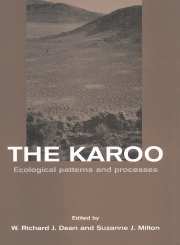Book contents
- Frontmatter
- Contents
- List of contributors
- Foreword
- Preface
- Acknowledgements
- Part one Biogeographic patterns and the driving variables
- Part two Form and function
- Part three Dynamics
- 11 Population level dynamics
- 12 Community patterns and dynamics
- 13 Modelling populations and community dynamics in karoo ecosystems
- 14 Spatially explicit computer simulation models – tools for understanding vegetation dynamics and supporting rangeland management
- Part four Human impacts
- Part five Comparisons
- References
- Index
12 - Community patterns and dynamics
Published online by Cambridge University Press: 23 December 2009
- Frontmatter
- Contents
- List of contributors
- Foreword
- Preface
- Acknowledgements
- Part one Biogeographic patterns and the driving variables
- Part two Form and function
- Part three Dynamics
- 11 Population level dynamics
- 12 Community patterns and dynamics
- 13 Modelling populations and community dynamics in karoo ecosystems
- 14 Spatially explicit computer simulation models – tools for understanding vegetation dynamics and supporting rangeland management
- Part four Human impacts
- Part five Comparisons
- References
- Index
Summary
Introduction
Patterns in the distribution of the biotic components are a function of the interaction between the biota and environmental variables. The vegetation and its associated biota co-evolved under common environmental conditions. These units are recognizable at different scales and will be discussed at the levels of biomes, landscapes and patches. Using geographic information systems and their associated spatial modelling capabilities, it has become possible to describe the environmental conditions associated with larger units in the landscape and to discriminate between units on the basis of the environmental correlates. The landscape may be viewed as units of differing size, and it is vital that scale be defined before discussing pattern. Early researchers were aware of the role that the environment plays in determining the spatial arrangement of the biotic components, and their results can be integrated into the interpretation of pattern in the landscape.
Following a strongly descriptive bias in research design, early interpretations (Marloth, 1908; Bews, 1916; Cannon, 1924) emphasize the diversity of growth forms, but do not relate growth form to abiotic conditions, or interpret patterns in the biome. Rutherford and Westfall (1986) divide the arid and semi-arid region of southern Africa into three biomes. The Desert biome is discriminated from the succulent and Nama-karoo biomes on the basis of the former's high summer aridity and low mean annual rainfall (<70 mm). In defining the boundaries between the Nama-karoo and the succulent karoo, Palmer and Hoffman (1997) attribute the differences in growth form characteristics of the biomes to a lower co-efficient of variation in annual rainfall, a stronger winter seasonality and a smaller temperature variation in the succulent karoo.
- Type
- Chapter
- Information
- The KarooEcological Patterns and Processes, pp. 208 - 223Publisher: Cambridge University PressPrint publication year: 1999
- 7
- Cited by



